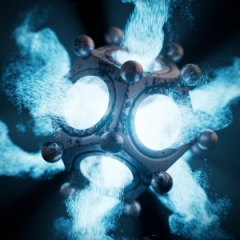Leaderboard
Popular Content
Showing content with the highest reputation on 04/02/2022 in all areas
-
I've been shooting images for decades - mainly amateur but some pro work as well. For years we've wanted softer softboxes with smoother diffusion and have cursed the unsightly umbrella rib lines in our reflections... and now in the world of CGI we're free from those flaws. Yay! But, umm... somehow it doesn't look right LOL!2 points
-
1 point
-
Oh don't get me wrong, CPU rendering still has it's place, especially for engines like Corona since they are so good for Archviz. Those scenes just need copious amounts of RAM which a GPU cannot provide. That said, compared to a GPU engine Corona is simply slow (relatively said) and for the scenes I would like to do with it (as hobby, not for my job) I would love to have a GPU option. I would just never reach the RAM limits 😉1 point
-
Well, there's BodyPaint, in native Cinema, which can paint on any channel in a material, and even a PBR material if memory recalls... However that is not very rewarding or intuitive to use so most people these days run out to Substance Painter for that sort of thing because of the vastly superior way it deals with seams and how easy it is to use. I certainly do... CBR1 point
-
It is true, I put a lot of effort into generating defects, after years of trying to hide them in photos. Lately I've been trying to off-center and angle my render cameras a bit. So easy to dial it in to 0 on X and 90 on H. A few degrees off makes a difference.1 point
-
We've told you several times that you don't need dynamics. The "reason" you don't need dynamics is because you do not require a rigid body collision to determine anything. All you need is an array of axes to stick to the surface of a plane. As a matter of fact, you don't even need to change their x or Z direction. You ONLY need to change their Y position. This should make a word pop into your head and that word is "projection". A projection has a very low calculation overhead compared to a rigid body simulation. So it just requires a little bit of un-thinking your process. 1) In the scene you provided, you put several vines in a row (maybe 10). That means the cloner is going to clone groups of 10 which will not conform to the surface. Start by pulling your individual elements out so that each can get cloned to a surface from their own axis. 2) Fix your axes, they all over the place. (The Axis Center tool with the Y slider bottomed out is your friend). 3) Clone on a uniform plane. 4) Project your simple uniform plane on your complex plane with a Shrink Wrap deformer. 5) Profit! Here's an oversimplified example. I just threw one vine and a post in a cloner. You could use fields or a formula effector to change the step patterns on the plane, but it's probably just as easy to use multiple planes (one for random posts, one for random vines, etc) for the easiest, most intuitive alignment.1 point
-
"Not a political Post" ... And yet it clearly is... with no actual point. Clearly you don't have the understanding or skill to use nodes. There freaking tonnes of plugins. Off you pop now you child.1 point
-
It’s the same thing in music. As soon as audio perfection was achieved, musicians started using tape emulators, analog synth emulators, old-school mixer emulators. And so on. Adding “non-linear” aspects is almost ubiquitous in productions these days. And to my ears it really sounds better. The richness of an instrument run through pro gear, emulated to perfection - warts and all - is so much nicer than digital cleanliness.1 point
-
Thank you so much for your quick response! Incredibly clear explanation, and it definitely makes much more sense to do it with the method shown in your video. Much to learn... Cheers! 🙂1 point
-
Blender has A LOT more developers than Maxon does specific to C4D. Blender Foundation gets A LOT of money which helps to pay for surge development in areas. Some developers are helping out on the side, providing fixes and code recommendations. It's something you don't see in most commercial software. Blender has less management hurdles, which is good and bad. Good is they can develop at break-neck speed without management telling them to look at the board of 20 features and pick only 3 to work on. The bad is they develop at break-neck speed and do things in a non-industry standard way while trying to copy the best features from other software. Their success is also what is holding them back from being utilized more. They think they know better than the industries they're breaking into. Studios won't use them as a main pipeline tool. The user base has grown considerably and also more mouthy over the past 2 years. Could you imagine if they tried to make sweeping changes in Blender now to bring things back into alignment? Pitchforks, torches, rope... witchery. That poor crappy Outliner and "collections" will never get any real love. 😕 Blender is content with being an outside force... one with balls to change the industry. In a way, Maxon should admire that and take some notes. Who cares if Maxon is accused of copying. Blender is popular now is because they copied the best features from other apps while doing it at such a pace that leaves other commercial devs at a loss. As the tickytocky shroomed up kids say.. "lets goooooo!" *puked a little*1 point
-
You've answered your own question - the geo nodes in Blender are fully developed and released functionality - Cinema's scene nodes are a tech preview and work in progress, so I'd hope it was obvious that it would be unfair to compare the two this early... I have every confidence that our geo nodes will be every bit as useful as Blender's. As for the reason the tech preview is included, that was partly in response to requests from the userbase about the future plans of Cinema, so is a good example of one occasion when they listened to their users, and also it serves as what I'd call a very sensible way to get its development seen by lots of users early on, so that they can give feedback, which will help develop their nodes to be as useful and helpful as they intend them to be. Already we are starting to see node based 'capsules' that are directly draggable into the OM to be used in traditional workflows, and some of those are hugely powerful (Rocket lasso's FUI capsules) or very useful NOW like some of the geometry operators which can, for example change the axis of a parametric object. As for who got there first, and why, not sure it matters, or that you would have accurate information about who started developing what, when !! If it's nodes we're talking about, Houdini got there before Blender, and Max a decade before that (its stack could be considered nodal to an extent) - so what ? Not sure what the point is there... CBR1 point
-
Have you seen any good geometry nodes Blender videos out there ? Because all I have seen is either short showcases and RnD without explaining how they did it or basic staff like how to distribute clones on surfaces. I haven't seen any tutorial on geometry nodes about anything C4D is not already capable of. In fact the main reason Blender developed Geometry Nodes was to compete for C4D's Fields and MoGraph. Most Blender users use GeometryNodes for something we've been doing for mor than 3 years. The most advanced GeometryNodes videos out there are about procedural buildings in the form of kit-bashing, something that Srek has told me is already possible with SceneNodes. There's a NAB or Motion Graphics video where Noseman explains how to build a procedural building using only cloners. People see Geometry Nodes and fail to see why nodes were really developed for other DCCs. Nodes offer a parametric, procedural, non-destructive way of building scenes or objects. C4D was already offering parametric, non-destructive and procedural tools, the problem was that not all tools where build or eventually became parametric and non-destructive. For example Spline Chamfer and Spline Outline are not non-destructive. In fact any orange colored tool is destructive and/or non-parametric. Some years ago Extruding was a destructive function, now we have it in the form of a deformer covering all the inconveniences. MAXON developed SceneNodes not because we lacked the modern scene-building workflows but because the improvement of the old tools would result in 30+ new deformers and generators doing the same thing as their orange twin counterparts. Having so many deformers and generators in a top-down hierarchy in the OM has its own drawbacks. The node system offers a way to arrange dependencies in 2D allowing for more complexity, using less tools to affect more things at the same time in less room. Patience, 20 April we'll have the new mid-term release and we will know how much things have advanced. C4D is a commercial product and always aimed at simple, fast and intuitive solutions. I prefer having an easy to use node system completed in 5 years rather a hard one right now. And right now I'm having both.1 point
-
OK, we've got your reduced scene, which means more people can load it, and then tell you exactly the same thing as we all did further up the page ! Dynamics is not suitable for that task in a scene of the proportions and scope you first posted. You should use something that is, like the Cloner (alone, no dynamics), or Forester's scatter functions, whatever they are, which will presumably be optimised for populating a vast landscape with thousands of mid to hi-poly clones. Or at least tell us what dynamics are doing for you that these other methods can't... However, in your newer test scene, dynamics does actually prevent the objects falling through the terrain - look - here they are not falling through ! Only thing I had to change to make that so was to go back to regular instances in the cloner, so dynamics can work properly. Of course that would be a terrible idea in your full scene, in all its multi-million poly vastness, so it merely underlines why this method isn't going to work here. CBR1 point
-
Thanks for the input. After giving it significant thought (and trying not to worry too much about the money), I decided to just build a new computer instead of upgrading the two cards. I'm currently running an 8700K, so my system is four years old now, with a processor that was released five years ago. It still runs great, but I probably wouldn't be getting everything I could out of a card upgrade with the existing processor, so I decided to upgrade to the 12900K, purchase one 3080, keep the 2080ti for now, and upgrade to another 3080 down the road or see what the next series brings. I've been using the same Cooler Master HAF case for years, so air flow with air cooling and space won't be an issue. I probably won't be doing any complex scenes, so the 24GB won't be necessary. I'm mainly looking to increase render speed for 2D and 3D animations. I use Blender for Grease Pencil, Freestyle, and 3D object animation, so the two cards will handle that. I use Toon Boom Harmony for my 2D character animation, so the CPU will handle that. I've just started a YouTube channel for animation, but my main job is as a graphic designer, so I'm telling myself I can justify the upgrade. The only downside I experienced upgrading the processor was that most of the motherboards that were available for it only supported DDR5. I planned to use my existing 64GB DDR4, but that wouldn't work, so I just ordered 32GB for now. That may be plenty. If not, I can expand later. Thanks again!1 point
-
I don't have a video. I have some threads. MODODO has made some serious stuff in here. And Chris Shmidt from Rocket Lasso has provided two Node Assets that are completely out of this world in terms of complexity and usefulness. The reason why you don't see many or any videos about C4D nodes is because C4D users have been used to a certain type of workflow and thinking that is completely different from the node system. There was a time where everyone was afraid of XPresso (me included), now most people know how to use it. Same with the SceneNodes. As the time passes and the system gets more mature more people will start using it. Currently he manual doesn't really help with nodes as their usability is not well documented with examples and screenshots being outdated from the previous versions. We expect many updates there soon. Blender has millions of users as it is the main application used by students and hobbyists from various fields not only CGI related. It is expected for a certain number of people to emerge with some very elaborate showcases. C4D has a much smaller user power so people with node showcases are very fewer.1 point
-
That's your opinion. I've used a lot of capsules for things I couldn't do before. Based on what data ? Your opinion again ? They started 6 months earlier. The project has more developers than any other DCC.1 point
-
I dunno - I haven't written off CPU rendering. Maybe if I did animation I would care more. I like the speed of Redshift, but Coronas VFB gets me there fast enough for look dev and for stills, final render times are still great with a threadripper. I'm glad I didn't have to navigate the GPU landscape and market for the last few years - brutal and expensive. I worked for so many years with physical renderer and 3-4 hour renders for one still, that it all still seems amazing and magic to me.1 point
-
You didn't mention you were using Forester. It would appear Forester was doing quite a bit of optimization for you in the background. If you remove forester from your plugins briefly and try to load the scene you posted you'll find out pretty quickly what you provided the forum with for review. There must be some kind of mograph conversion for compatibility, but it's crippling. I mean... not even using render instances or multi-instances. Hopefully there's someone on the forum who has Forester who can help you further. 👍 <irrelevant rant> Everything in the known universe is bound to a scale where it operates comfortably (everything). And this is why it doesn't matter how many gigs of RAM you have, or if you have the latest RTX card... the best upgrade you could get is the curiosity of how C4D (or any system) operates under the hood. Way more valuable than just throwing CPU/CUDA cores (money) at it. When someone says "it should just work" - I hear "I shouldn't have to learn how it works". Well you don't... you don't have to learn how anything works, but it puts you in a pretty lousy position in life. Soon enough, everything just becomes magic and you have to hire magicians to fix it. 😉1 point
-
Been years since I had to do much searching for Cinema 4D answers (apart from Redshift) but I was specifically interested in character work and found it hard to find good character based tutorial series. There might be more around these days with the improvement of C4D's character offering but back when I was learning C4D there were a couple from Brett Bays but I didn't find much else (maybe wasn't looking hard enough). EJ from Eyedesyn was helpful for a lot of neat tricks. Specifically regarding character tutorials there are just a shitload of resources for Blender on YouTube. And sites like CG Cookie are great quality. This ain't a Blender program is better than Cinema 4D program post, I just found when it comes to character learning Blender has been easier to sort through. I'm sure there's heaps of mograph, archviz, rendering, lighting etc learning content for Cinema 4D but character workflows seemed slim.1 point
-
1 point





